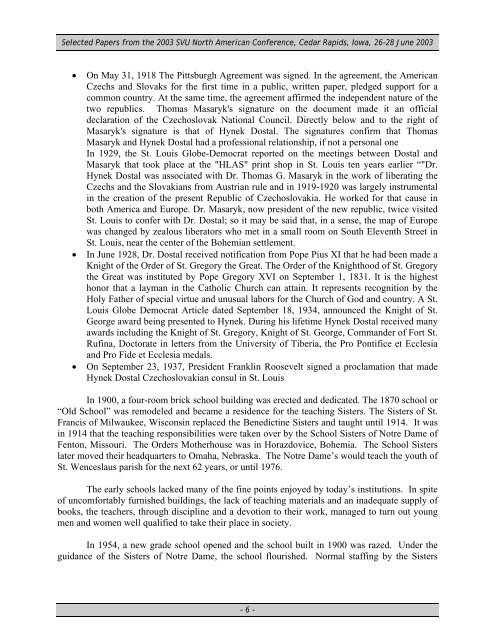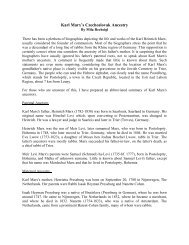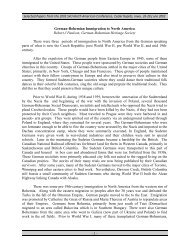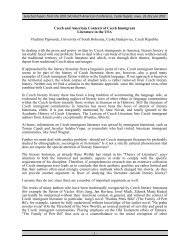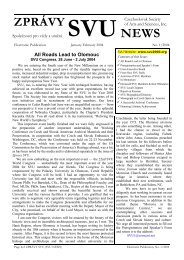Oh, if only these walls could speak - Czechoslovak Society of Arts ...
Oh, if only these walls could speak - Czechoslovak Society of Arts ...
Oh, if only these walls could speak - Czechoslovak Society of Arts ...
Create successful ePaper yourself
Turn your PDF publications into a flip-book with our unique Google optimized e-Paper software.
Selected Papers from the 2003 SVU North American Conference, Cedar Rapids, Iowa, 26-28 June 2003<br />
• On May 31, 1918 The Pittsburgh Agreement was signed. In the agreement, the American<br />
Czechs and Slovaks for the first time in a public, written paper, pledged support for a<br />
common country. At the same time, the agreement affirmed the independent nature <strong>of</strong> the<br />
two republics. Thomas Masaryk's signature on the document made it an <strong>of</strong>ficial<br />
declaration <strong>of</strong> the <strong>Czechoslovak</strong> National Council. Directly below and to the right <strong>of</strong><br />
Masaryk's signature is that <strong>of</strong> Hynek Dostal. The signatures confirm that Thomas<br />
Masaryk and Hynek Dostal had a pr<strong>of</strong>essional relationship, <strong>if</strong> not a personal one<br />
In 1929, the St. Louis Globe-Democrat reported on the meetings between Dostal and<br />
Masaryk that took place at the "HLAS" print shop in St. Louis ten years earlier “"Dr.<br />
Hynek Dostal was associated with Dr. Thomas G. Masaryk in the work <strong>of</strong> liberating the<br />
Czechs and the Slovakians from Austrian rule and in 1919-1920 was largely instrumental<br />
in the creation <strong>of</strong> the present Republic <strong>of</strong> <strong>Czechoslovak</strong>ia. He worked for that cause in<br />
both America and Europe. Dr. Masaryk, now president <strong>of</strong> the new republic, twice visited<br />
St. Louis to confer with Dr. Dostal; so it may be said that, in a sense, the map <strong>of</strong> Europe<br />
was changed by zealous liberators who met in a small room on South Eleventh Street in<br />
St. Louis, near the center <strong>of</strong> the Bohemian settlement.<br />
• In June 1928, Dr. Dostal received not<strong>if</strong>ication from Pope Pius XI that he had been made a<br />
Knight <strong>of</strong> the Order <strong>of</strong> St. Gregory the Great. The Order <strong>of</strong> the Knighthood <strong>of</strong> St. Gregory<br />
the Great was instituted by Pope Gregory XVI on September 1, 1831. It is the highest<br />
honor that a layman in the Catholic Church can attain. It represents recognition by the<br />
Holy Father <strong>of</strong> special virtue and unusual labors for the Church <strong>of</strong> God and country. A St.<br />
Louis Globe Democrat Article dated September 18, 1934, announced the Knight <strong>of</strong> St.<br />
George award being presented to Hynek. During his l<strong>if</strong>etime Hynek Dostal received many<br />
awards including the Knight <strong>of</strong> St. Gregory, Knight <strong>of</strong> St. George, Commander <strong>of</strong> Fort St.<br />
Rufina, Doctorate in letters from the University <strong>of</strong> Tiberia, the Pro Pont<strong>if</strong>ice et Ecclesia<br />
and Pro Fide et Ecclesia medals.<br />
• On September 23, 1937, President Franklin Roosevelt signed a proclamation that made<br />
Hynek Dostal <strong>Czechoslovak</strong>ian consul in St. Louis<br />
In 1900, a four-room brick school building was erected and dedicated. The 1870 school or<br />
“Old School” was remodeled and became a residence for the teaching Sisters. The Sisters <strong>of</strong> St.<br />
Francis <strong>of</strong> Milwaukee, Wisconsin replaced the Benedictine Sisters and taught until 1914. It was<br />
in 1914 that the teaching responsibilities were taken over by the School Sisters <strong>of</strong> Notre Dame <strong>of</strong><br />
Fenton, Missouri. The Orders Motherhouse was in Horazdovice, Bohemia. The School Sisters<br />
later moved their headquarters to Omaha, Nebraska. The Notre Dame’s would teach the youth <strong>of</strong><br />
St. Wenceslaus parish for the next 62 years, or until 1976.<br />
The early schools lacked many <strong>of</strong> the fine points enjoyed by today’s institutions. In spite<br />
<strong>of</strong> uncomfortably furnished buildings, the lack <strong>of</strong> teaching materials and an inadequate supply <strong>of</strong><br />
books, the teachers, through discipline and a devotion to their work, managed to turn out young<br />
men and women well qual<strong>if</strong>ied to take their place in society.<br />
In 1954, a new grade school opened and the school built in 1900 was razed. Under the<br />
guidance <strong>of</strong> the Sisters <strong>of</strong> Notre Dame, the school flourished. Normal staffing by the Sisters<br />
- 6 -


